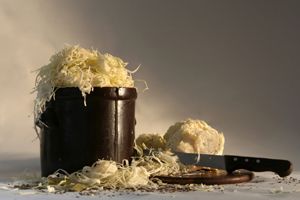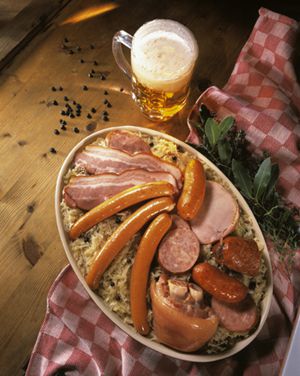Sauerkraut ('choucroute' in French language)

The beginnings were the sour soups, early prepared with young small branches, buds and/or leaves of birches, nettle and sorrel.
One discovered signs of pickled cabbage during the neolitic ages in the German food and in the food of numerous central European peoples. Starting XVIIIth century, the first manufactures for the 'industrialisation' of the barrels of cabbage settled in Magdeburg (Germany), then in Strasbourg (Alsace, France). Captain James Cook, in the 1770-1780s declared that its expeditions had been successful partly due to pickled cabbage. Actually, the addition of fermented cabbages into the daily food of the crews (thanks to the phosphorus, potassium and vitamins contained in them)had contributed to avoid some deficiencies and diseases due to lack of vitamins like scurvy. The British dealers of that time quickly understood its commercial interest and therefore settled wharehouses in many harbours ("the Sauer Kraut Magazins" where the expedition captains used to get their supplies before departure.
Later on, the usage of "salted herbs" allowed the first American settlers to go through rigourous winters.
We find all these old usages so called "From Old France" in the Acadian cuisine. Actually, our far cousins still preserve in salt cabbage, herbs ans mainly French pod beans they store in stoneware pots ("les croques" in Acadian French)

Quite easy ; you will find below many ways to make eat it. Then why, you epicurian men and women wouldn't you try the experiment and prepare our own home made pickled cabbage ?
The most appropriate cabbage variety is the (in French language) the 'quintal d'Alsace' ('quintal' means litterally 'one hundred kilogrammes' which illustrates that this variety of cabbage is quite big !) - I could not find, if available - the English equivalent.
Preparation :
keep aside 2 large nice leaves of your cabbage, then take away its stalk (throw it) and slice thinly the cabbage (if you find one, you can use a special grater). Wash it and put a 10 centimeter - 4 inch - thick layer of it at bottom of a high container, then put a layer of coarse salt and a few juniper berries spread in it. Pack it well a uniform way so that a salty juice starts to go out and up on top. Repeat the whole sequence. The last layer must be completely covered by the salted juice produced by the successive pressure. Finally, cover with the 2 leaves put aside (see above)and then cover with a wooden lid slightly smaller than your container. Put an heavy weight on top.
The following day, because of the pressure, water will cover the lid ; you can take away a part of it but the lid must always be totally under water. Keep your container in a cool place for at leat one month. When froth is no longer produced, then the pickled cabbage is ready for consumption and you can keep it for several months like that. You can then substitute fresh clean water to the salted liquid.
The first time you will open the container, don't be surprised by the strong unpleasant and agreesive smell : it results from the fermentation of the cabbage and this is normal. Do not forget to rince your pickled cabbage before using it for cooking.
When you want to take some cabbage out of the contained, first take away some liquid from the top, and after cover again the cabbage with the 2 leaves, rince the wooden lid with warm hot before puting it back on the cabbage leaves and do not forget the heavy weight. Always cover with fresh clean water.
In the past, people used to like picked cabbage having lasted for a long time in the brine (and so having become yellowish) : the taste of the consumers has changed and they now prefer crunchy cabbage, i.e. having staid a shorter time in the brine.
Hansi, THE great Alsacian drawer said the following : " pickled cabbage must always been meticulously simmered, patience and long lasting are the secret of it and this is why sauerkraut is a sunday dish".
Sometimes, reading old ccoking books, the unexpected comes. For instance, we can read that until the 20th century, some families were still serving sauerkraut together with mashed split peas.

Find below the "sauerkraut of Colmar housekeepers recipe" (Colmar is a very old city of Alsace), one of the oldest ones to day.
Proportions for 6 people
In a pot going into the oven, gently bake with no colour 2 thinly sliced onions in 50 grams (1.5 onces) of goose fat so that it makes a layer on bottom of the pot then pour alayer of 500 grams (1 'big' pound) of raw pickled cabbage, add salt (not much) and peper and let it gently bake covered with the pot lid during 15 minutes. Then add 15 centiliters (1 cubic inch) of Sylvaner wine (dry white Alsacian wine, a raw apple cut in large segments and a few juniper berries that you have wrapped in a thin white cloth. Then pour beef stock to cover the cabbage and cook it in the oven at a temperature of 170° celsius (338°F)during 3 hours but after the first 2 hours, add a piece (1 kilogramme = 2.2 pounds approx.)of smoked steaky bacon and 15 minutes before the end of the total 3 hours, pour 5 centiliters (1/3 of the quantity of the wine you added) of 'kirsch' (dry white cherry brandy).
Presentation :
the sauerkraut is presented "crowned" by the steaky bacon sliced, roasted pork ribs ans small sausages (knackis type)and boiled (with their skin)peeled potatoes around the whole. Some purits say that the "real" sauerkrut is served with the 3 sacred sausages (Frankfurt, Strasbourg and Montbéliard).
Other purists, settled on the other bank of the Rhin river (i.e. in Germany)request the addition of fried oysters !...
And now, sauerkrut "from the sea".
It has been made popular by the famous "restaurant Baumann" in Paris in the 1970s and are still very popular.
The only difference with the above detailed recipe is that no fat (goose or pork fat or even steaky bacon) is added ; we moisten with a large glass of Sylvaner wine plus, up to the level of the cabbage with a good chicken custard base before going into the oven.
An infinite number of combination of sea food ingredients is possible ; smoked fish (halibut, salmon, haddock) but also some delicate fish like monk fish or turbot sections, dover sole filets. You can also try scallops or queen scallops. Insert them into the pickled cabbage and let them cook in accordance with the thickness and the texture of the fish (15 minutes for a monk fish segment, 10 minutes for sole filets,... You can serve the dish with a "beurre blanc" (in French) butter with white wine and shalots sauce in a separate sauce pan.
The interest of pickled cabbbage is that such cooked cabbage can be served as vegetables for numerous basis like roasted goose or duck, pheasant, young partridge, but also snails, fried eggs, sausages or black sausage, andouillettes, poultry quenelles ... And what about a pan fried pikeperch or an escalope of fresh salmon or of goose liver just pan fried.
We can also make delicious soups and even sauerkraut covered with grated cheese and gratinated.
And now 2 recipes you can find on our site :
-> the alsacian sauerkraut
-> the alsacian thick round of pork in sauerkraut
And for the ending :2 original sauerkraut recipes
1) The pickled cabbage salad
Wash several times your raw pickled cabbage, moisten it to just cover it and let it cook during 15 minutes. Rince it thoroughly and let it cool down.
Make a mayonnaise with mustard and a bit of grated horseradisch.
Add the cabbage, stir and add small cubes of sausages (Lyon or Morteaux - I am not sure one can find an appropriate transalation ?) plus some thin slices of saveloy.
A pure delight.
2) Pickled cabbage with chestnuts
In cooked pickled cabbage, add skinned and baked chestnuts and some segments or raw apple : the combination of cabbage and chestnut is just divine !
At last, I am fully aware that I only lightly touched this mytical recipe and that each county of the East (Alsace) has its own geniune one. I so invite all of you to use these pages of recipe proposals in order to deapen even more the level of our knowledge and of culinary share.




leave a message or a photo